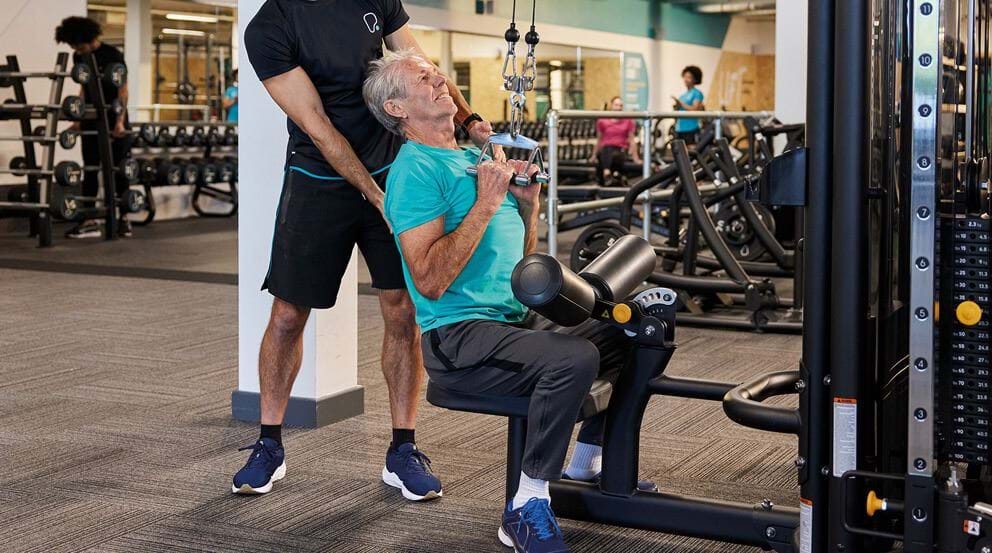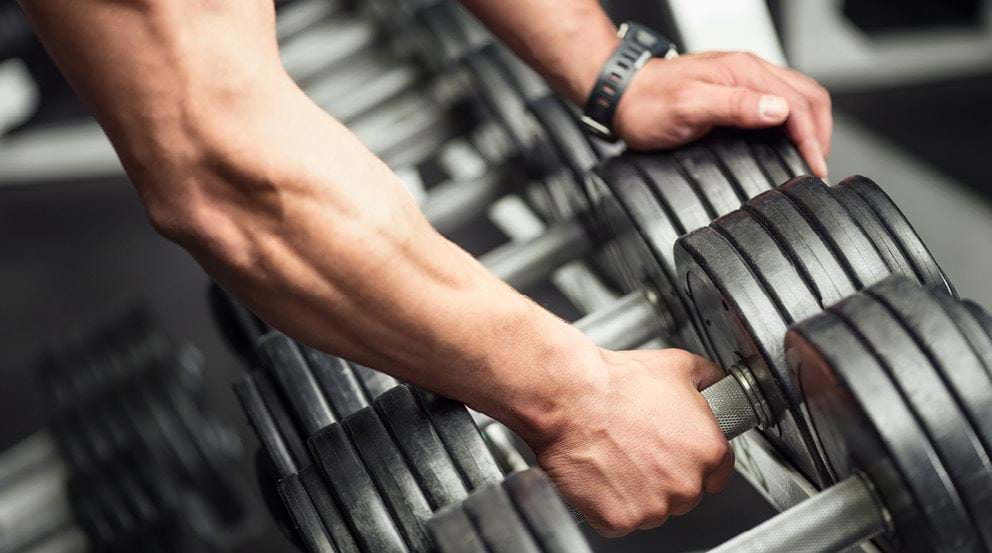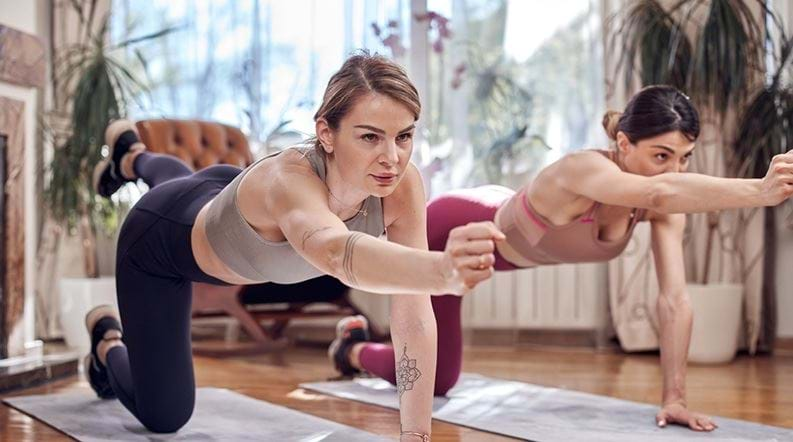Resistance Training for Seniors: Workout Plans and Approach

Why Resistance? | Benefits For Seniors | Low Impact Plan | Full Body Plan | Fully Seated Plan | Getting Started | Progressing
Resistance training, such as lifting weights or using resistance bands, is a fantastic way for older adults and seniors to improve their fitness and overall health.
According to the NHS, adults aged 65 and over should aim to be physically active every day and include activities that enhance strength, balance, and flexibility at least twice a week.
Resistance training is an ideal way to build strength, as it can be easily tailored to suit individual abilities, fitness levels, and mobility.
You can learn more about resistance training (what is it and why should you do it) here. Or, read on for a comprehensive guide to help seniors enjoy a safe and effective resistance training programme.
Why Is Resistance Training So Great For Seniors ?
Resistance training is an excellent fitness style for people of all ages, but it’s particularly suitable for seniors. It’s safe, adaptable, and directly addresses some of the physical challenges of ageing, such as muscular hypertrophy, bone loss, and poor balance.
Unlike high-impact activities like running, resistance training is gentle on the joints, making it ideal for older adults who may experience arthritis or joint pain. It’s also highly customisable, so you can start with light weights or resistance bands and gradually increase intensity as you build strength.
Plus, the exercises involve slow, controlled movements. This means they’re easy to learn and perfect, so you’re less likely to injure yourself.
Benefits Of Resistance Training For Seniors
Resistance training specifically targets age-related issues like muscle loss and declining bone density. It's the perfect way for seniors to stay active, independent and strong.
Here are just a few of the benefits you can enjoy with a consistent resistance routine:
- Stronger muscles: As people get older, they naturally lose muscle. As shown by the National Institute on Aging, resistance training helps rebuild and keep muscles strong. This makes it easier to do everyday activities like carrying shopping or climbing stairs.
- Healthier bones: Studies show that it strengthens bones too, lowering the risk of osteoporosis (which makes bones weak and more likely to break).
- Better balance: More than one in four older people have a fall each year, with one in 10 falls resulting in a restrictive injury. Stronger muscles mean better balance and coordination, which helps prevent falls.
- More energy: Do you ever find the less you do, the more tired you feel? Resistance training can boost overall energy levels and make you feel less tired.
- Improved mood: Exercise, including resistance training, releases feel-good chemicals in the brain, making it an excellent mood booster. Studies have shown.) that it's great for tackling stress and depression.
- Easier weight control: It helps maintain a healthy weight by building muscle, which burns more calories, even when resting.
The Best Safe and Easy Resistance Exercises for Seniors
We’ve put together some resistance workout options below that are perfect for older adults looking to maintain strength. These plans are gentle, yet effective, aimed to target the needs of seniors while keeping your workout safe and injury-free.
You’ll ideally need a set of resistance bands or light dumbbells. If you don’t have these, a pair of tights, a towel or a belt can work in place of the bands, while, a water bottle, book or can of beans or soup can replace the dumbbells.
If you find that bearing any weight is a struggle, simply start with body weight, working through the movements in a controlled way to build strength.
Workout Plan 1: Low Impact Resistance Exercises
This workout is designed to be gentle on the joints while still building strength and improving mobility. Perfect for beginners or those with joint pain, it focuses on controlled movements to safely engage key muscle groups.
Duration: ~20-25 minutes
Equipment: Resistance bands or light dumbbells
- Warm up: seated or standing shoulder rolls
- Roll shoulders forward and backwards slowly.
- Perform for 1-2 minutes.
- Wall push-ups (chest & arms)
- Stand facing a wall, hands placed on the wall shoulder-width apart.
- Lower your body towards the wall by bending your elbows, then push back to standing.
- Perform 10-15 reps.
- Resistance band bicep curls (arms)
- Sit or stand, placing the middle of a long resistance band under your feet and holding each end in your hands.
- With your palms facing upwards, curl your hands toward your shoulders, then lower.
- Perform 12-15 reps.
- Side-lying leg lifts (hips & outer thighs)
- Lie on your side, supporting your head with your hand.
- Keeping your toes facing forward and legs straight, raise the top leg to about a 45-degree angle. Hold briefly, then lower.
- Perform 12 reps per side.
- Seated calf raises (lower legs)
- Sit with your feet flat on the floor and knees together.
- Lift your heels as high as possible so your toes are pointed, then lower.
- Perform 15-20 reps.
- Bird dog (modified) (core & balance)
- Perform on your hands and knees or standing with one hand on a sturdy surface.
- Extend one arm forward while simultaneously stretching the opposite leg backwards, keeping both straight and aligned with your body.
- Perform 10 reps per side.
- Cool down: chest opener stretch
- Clasp hands behind your back and gently lift them.
- Hold for 15-20 seconds.
Workout Plan 2: Full Body Resistance Exercises for Key Muscle Groups
Target your core muscle groups with this workout, designed to build functional strength for daily activities. Each exercise focuses on a specific area, helping to improve balance, posture, and overall body strength.
Duration: ~25 minutes
Equipment: Resistance bands or light dumbbells
- Warm up: seated knee marches
- Sit tall and march your legs while swinging your arms.
- Perform for 2 minutes.
- Seated chest press (chest & shoulders)
- Loop a resistance band behind your back, with each hand holding onto the ends and fists facing the floor. Alternatively, you can hold light weights.
- Push your arms forward until nearly straight, then return.
- Perform 12-15 reps.
- Seated row (upper back)
- Loop a resistance band around your feet.
- With your arms straight down at your sides, hold the ends of the band so it's tight. Or use light weights.
- With your fists facing into your body, pull your hands upwards toward your waist, squeezing your shoulder blades together.
- Gently lower back to the starting position.
- Perform 12 reps.
- Leg extension (quads)
- Straighten one leg, hold briefly, then lower.
- Add ankle weights if desired.
- Perform 12 reps per leg.
- Hip abduction (hips & outer thighs)
- Tie or place a resistance band around your thighs.
- Keeping your feet together, push your knees outward, then return.
- Perform 15 reps.
- Seated overhead press (shoulders & arms)
- Hold dumbbells or loop a resistance band under your seat or bottom.
- Hold each end of the band firmly with hands at shoulder height and palms facing forward.
- Push both arms upwards until fully extended, then lower to shoulder height.
- Perform 12-15 reps.
- Cool down: seated side stretch
- Sit tall on a sturdy chair with feet flat on the floor, hip-width apart.
- Raise one arm overhead, keeping it straight, and gently lean to the side.
- Repeat with the other arm.
- Hold for 15 seconds per side.
Workout Plan 3: Fully Seated Resistance Training
This seated workout is ideal if you prefer a stable position or need to avoid standing exercises. It strengthens the entire body while minimising strain, making it safe and accessible for everyone.
Duration: ~20-25 minutes
Equipment: Resistance bands, light dumbbells, or none
- Warm up: seated arm circles
- Sit tall and extend your arms out to the sides at shoulder height.
- Make small circles forward, then backwards.
- Perform for 1-2 minutes.
- Seated shoulder press (shoulders & arms)
- Hold light dumbbells or a resistance band anchored under your feet or chair.
- With palms facing forward, push both arms straight overhead, then lower.
- Perform 12 reps.
- Seated side twists (core & obliques)
- Sit tall with a light weight or ball held at chest level.
- Keeping your hips stable, twist your torso gently to each side, engaging your core.
- Perform 10 reps per side.
- Seated leg press (quads & hamstrings)
- Loop a resistance band around the ball of one foot and hold the ends securely.
- Push your foot forward, straightening your leg fully as if pressing an accelerator pedal, then return.
- Perform 12 reps per leg.
- Seated bicep curls (arms)
- Sit tall, holding dumbbells or the ends of a resistance band that's anchored under your feet.
- Start with arms at your sides, palms facing up.
- Keeping your elbows close to your body, curl your hands toward your shoulders, then lower.
- Perform 12 reps.
- Seated back rows (upper back)
- Loop a resistance band around your feet, holding the ends with both hands down by your sides.
- Pull the band toward your waist, squeezing your shoulder blades together.
- Perform 12 reps.
- Seated calf raises (lower legs)
- Sit with feet flat on the floor. Lift your heels off the floor as high as possible, hold briefly, then lower back down.
- Perform 15-20 reps.
- Cool Down: neck stretches
- Sit tall and gently tilt your head to each side, bringing your ear towards your shoulder. Hold for 15 seconds per side.
How To Start A Resistance Training Programme For Seniors
If you have any major health concerns then it's worth speaking to your healthcare provider to make sure the exercises are suitable for your health and fitness level.
Start with light weights or resistance bands to keep the movements manageable and avoid strain. Perform 1 to 2 sets of 8 to 12 repetitions for each exercise, focusing on proper form and slow, controlled movements. By performing each exercise slowly and carefully, you'll benefit more from them and are less likely to injure yourself.
As your strength improves, gradually increase the weight or resistance and the number of repetitions. Aim to complete 2 to 3 resistance training sessions per week to see steady progress and maintain your strength over time.
Always warm up with dynamic stretches or light movement before every workout. Then, make sure to cool down with some static stretches afterwards. This will help prevent your muscles from aching after exercise and help to prevent injury.
How To Build Progress And Increase Difficulty Level
While you may be keen to lift heavier weights as quickly as possible, it's important to focus on performing each exercise correctly. If you increase the difficulty level too quickly, you could cause an injury and slow your progress down.
Beginners should start with bodyweight exercises, resistance bands and light weights, like in the workout plans provided above. Focus on perfecting each movement and gradually building strength. If you start to find these movements too easy, you can increase the weights, or use a heavier strength resistance band. You can also increase the number of reps and sets you do for each exercise
If you're ready to progress beyond weights and bands, you could focus your workouts more on free weights or weight machines, either in the gym or at home. Check out our gym machine workout for beginners or this beginner's guide to training with free weights for more on these.
Looking for more inspiration?
Check out some of our guides for seniors below to discover more ways to stay fit and healthy:
- 8 of the best seated and chair exercises for seniors
- Simple exercises for older adults
- HIIT for seniors
- 8 back strengthening exercises for seniors
- 16 best pieces of gym equipment for seniors
- 5 of the best balance exercises for seniors
Getting started on fitness in your older years can sometimes feel intimidating, but there's plenty of help available for you if you're a PureGym member. One of our expert personal trainers will be able to show you a range of workouts and exercises to best suit your body and your goals.


